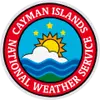

East to northeast at 10 to 15 knots.
Slight to moderate with a wave height of 2 to 4 feet.
When we talk about the weather, we are really describing the conditions in the atmosphere and the air around us at a particular moment. If you look outside now you might see that the weather is cloudy or sunny, or that it is wet or windy.
A hurricane is a tropical cyclone with maximum sustained winds of 64 knots or 74 miles per hour.
The Cayman Islands experience two distinct weather patterns: dry, cool conditions marked by the passage of cold fronts across the country between December and February; and warm, wet conditions marked by the passage of tropical waves across the country between Mid-May through November.
High School: The first step for any student in high school considering a career in meteorology is to take as many physical science courses and mathematics as possible. It is also important to become familiar with the use of computers for problem solving, writing and communications. Therefore high school students with an interest in a career as meteorologist should take every mathematics, physics and computer courses that are available.
University : The majority of practicing meteorologists hold at least an undergraduate degree (Bachelor of Science) in meteorology. In addition to the required or core courses in meteorology, the program also includes basic courses in mathematics, physics, chemistry, and computer science. The typical degree program is as vigorous as any engineering program. Most meteorology undergraduates who wish to receive high grades will need to sacrifice some of their social life. So for all who want to grow up and be called a "meteorologist," the message is math, science, math, science …. Study hard, make some sacrifices, and the rewards will most assuredly be there.
The Saffir-Simpson Hurricane Wind Scale is a classification used for hurricanes. The scale divides hurricanes into five categories distinguished by the intensities of their sustained winds. The classifications are intended primarily for use in measuring the potential damage and flooding a hurricane will cause upon landfall.
These links provide listings of some meteorological instruments and descriptions of weather instruments and the parameter they measure. This link also has instructions on how to make simple weather instruments.
The rainy season starts around the mid to end of May.
Storm surge is the onshore rush of sea caused by the high winds associated with a land falling cyclone and also by the low pressure of the storm. Its effects can be made worst if the cyclone makes landfall at a time of high astronomical tide.
Hurricane Ivan in 2004 affected Grand Cayman with 150 mph winds, Hurricane Paloma in 2009 affected Cayman Brac with 140 mph winds.
The hurricane season in the Atlantic, Caribbean and Gulf of Mexico runs from 1st June to 30th November each year. However, there have been several cyclones that have formed before and after this period.
At first there has to be an initial disturbance such as a tropical wave or the tail end of a stationary frontal zone. As the system further develops a closed circulation it becomes a depression. Further intensification leads to a tropical storm (maximum sustained winds 39 to 73 mph). At this stage it is given a name. As the storm strengthens and maximum sustained winds reach 74 mph and greater, it is upgraded to a hurricane. Then hurricanes are further classified according to categories on the Saffir-Simpson Wind Scale.
A major hurricane is one that is either a Category 3, 4 or 5 on the Saffir-Simpson Wind Scale.
A tropical wave is a perturbation in the mean easterly flow over the tropics. Convection usually accompanies these waves and conceptual models show this activity is placed to the east of the axis.
Climate refers to average weather conditions over a long period of time. Weather describes the conditions in the atmosphere and the air around us at a particular instant.